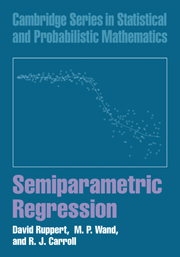Book contents
- Frontmatter
- Contents
- Preface
- Guide to Notation
- 1 Introduction
- 2 Parametric Regression
- 3 Scatterplot Smoothing
- 4 Mixed Models
- 5 Automatic Scatterplot Smoothing
- 6 Inference
- 7 Simple Semiparametric Models
- 8 Additive Models
- 9 Semiparametric Mixed Models
- 10 Generalized Parametric Regression
- 11 Generalized Additive Models
- 12 Interaction Models
- 13 Bivariate Smoothing
- 14 Variance Function Estimation
- 15 Measurement Error
- 16 Bayesian Semiparametric Regression
- 17 Spatially Adaptive Smoothing
- 18 Analyses
- 19 Epilogue
- A Technical Complements
- B Computational Issues
- Bibliography
- Author Index
- Notation Index
- Example Index
- Subject Index
17 - Spatially Adaptive Smoothing
Published online by Cambridge University Press: 06 July 2010
- Frontmatter
- Contents
- Preface
- Guide to Notation
- 1 Introduction
- 2 Parametric Regression
- 3 Scatterplot Smoothing
- 4 Mixed Models
- 5 Automatic Scatterplot Smoothing
- 6 Inference
- 7 Simple Semiparametric Models
- 8 Additive Models
- 9 Semiparametric Mixed Models
- 10 Generalized Parametric Regression
- 11 Generalized Additive Models
- 12 Interaction Models
- 13 Bivariate Smoothing
- 14 Variance Function Estimation
- 15 Measurement Error
- 16 Bayesian Semiparametric Regression
- 17 Spatially Adaptive Smoothing
- 18 Analyses
- 19 Epilogue
- A Technical Complements
- B Computational Issues
- Bibliography
- Author Index
- Notation Index
- Example Index
- Subject Index
Summary
Introduction
The penalty parameter λ of a penalized spline controls the trade-off between bias and variance. In this chapter we introduce a method of fitting penalized splines wherein λ varies spatially in order to accommodate possible spatial nonhomogeneity of the regression function. In other words, λ is allowed to be a function of the independent variable x. Allowing λ to be a function of spatial location can improve mean squared error (MSE; see Section 3.11) and the accuracy of inference.
Suppose we are using a quadratic spline that has constant curvature between knots. If the regression function has rapid changes in curvature, then a small value of λ is needed so that the second derivative of the fitted spline can take jumps large enough to accommodate these changes in curvature. Conversely, if the curvature changes slowly, then a large value of λ will not cause large bias and will reduce dffit and the variance of the fitted values. The problem is that a regression function may be spatially nonhomogeneous with some regions of rapidly changing curvature and other regions of little change in curvature. A single value of λ is not suitable for such functions. The inferiority – in terms of MSE – of splines having a single smoothing parameter is shown in a simulation study byWand (2000). In that study, for regression functions with significant spatial inhomogeneity, penalized splines with a single smoothing parameter were not competitive with knot selection methods. In an empirical study by Ruppert (2002), the spatially adaptive penalized splines described in this chapter were found to be at least as efficient as knot selection methods.
- Type
- Chapter
- Information
- Semiparametric Regression , pp. 293 - 307Publisher: Cambridge University PressPrint publication year: 2003

